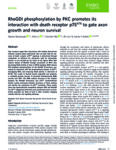In our latest paper, we show that the p75 neurotrophin receptor p75NTR can signal very differently in diferent types of neurons. Using pharmacological and genetic techniques, we demonstrate that this is partly controlled by differential proteolytic cleavage of the receptor in different cell types. The new work has appeared online in the Journal of Cell Science.
Signaling by the p75 neurotrophin receptor (p75NTR) is often referred to as cell-context dependent, but neuron-type specific signaling by p75NTR has not been systematically investigated. Here, we report that p75NTR signals very differently in hippocampal neurons (HCNs) and cerebellar granule neurons (CGNs), and present evidence indicating that this is partly controlled by differential proteolytic cleavage. NGF induced caspase-3 activity and cell death in HCNs but not in CGNs, while it stimulated NFκB activity in CGNs but not in HCNs. HCNs and CGNs displayed different patterns of p75NTRproteolytic cleavage. While the p75NTR carboxy terminal fragment (CTF) was more abundant than the intracellular domain (ICD) in HCNs, CGNs exhibited fully processed ICD with very little CTF. Pharmacological or genetic blockade of p75NTR cleavage by gamma-secretase abolished NGF-induced upregulation of NFκB activity and enabled induction of CGN death, phenocopying the functional profile of HCNs. Thus, the activities of multifunctional receptors, such as p75NTR, can be tuned into narrower activity profiles by cell-type-specific differences in intracellular processes, such as proteolytic cleavage, leading to very different biological outcomes. Read the full article HERE.



